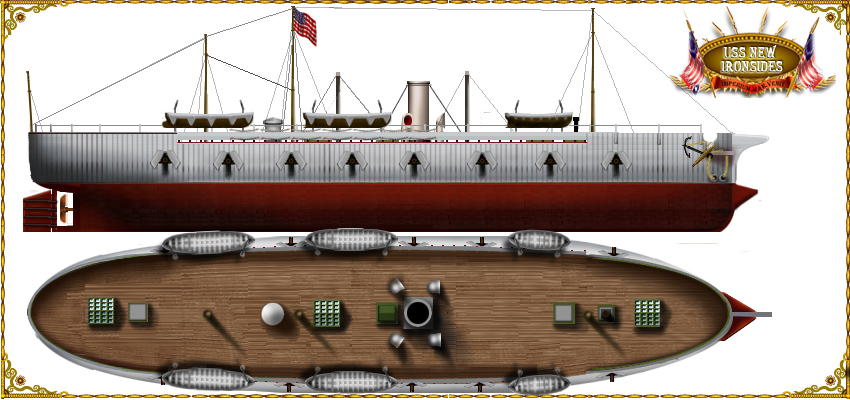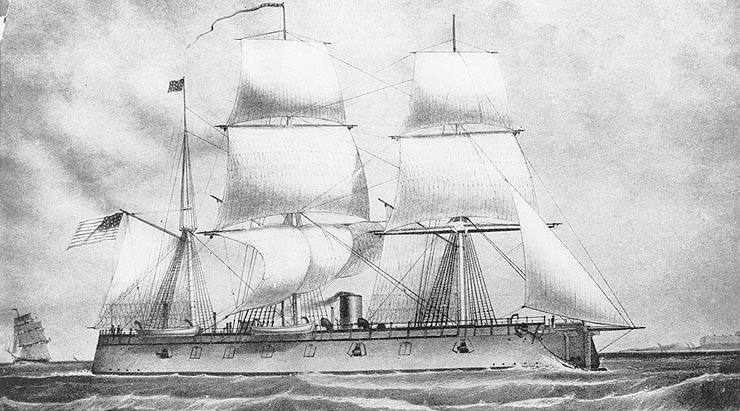 Union Navy
Union Navy

USS New Ironsides after reconstruction in 1864
The American sea-going ironclad (1862-66)
The USS New ironsides was the sole true sea going ironclad of the entire Secession war, and the first of the united states.
As soon as the Union admiralty had clues about a new confederate ironclad, future CSS Virginia, requirements for a new ironclad, and perhaps more to come, were issued. In fact, many designs were submitted, and three were retained. The first was the most revolutionary and cutting-edge technological marvel: The Monitor. The other was the rail-covered USS Galena, with a turtleback hull to deflect gun shots, and eventually, USS New Ironsides, a sea-going ironclad.
Of course the surname which became popular was inspired by her first namesake : The “old” versus the “new” ironsides, as the first, historical frigate was affectionately called “old ironsides”. And the “new” ironsides was truly iron-armoured contrary to the 1797 frigate.

USS New Ironsides with full rigging as completed in 1862.
Design
This ship was more an American version of the French “Gloire” rather than inspired by the HMS Warrior. It was short, wide, possessed a wooden hull covered with iron plating and coppered below waterline, three masts and a single artillery deck with side Dalghren guns. Armour was complete, extending from the entire length of the hull, from one meter below waterline to the upper gallery. The hull was flat-bottomed, with a rectangular ram, there was a single funnel. Merrick & Sons made the design proposals, but construction took place at William Cramp and Sons as sub-contractor, in NYC.
Just after the battle of Hampton roads, the original planned armament of sixteen 9in Dalghren guns was changed to fourteen 11in Dalghren guns and two 8in Parrot rifles. Later on, two chase 50-pounders, and several 60-pounder guns (5in) were added on the upper deck.
Active life
The ship was launched in may 1862 and commissioned in august. Shortly after commission she sailed for Hampton roads, joining the blockade under Rear Admiral Goldsborough‘s command. Some steering and gun recoil problems occurred after trials, never really solved until September when she returned from Philadelphia Yard to Hampton roads to resume blockading operations, assisted by USS Monitor and Galena, the two other “ironclads” of the Union.
This routine went on until the night on 5 October 1863, when CSS David successfully “torpedoed” her. Badly damaged, she was decommissioned for extensive repairs and complete reconstruction, re-commissioned in august 1864. She had no masts nor rigging (see the illustration) notably, and spent her late career chasing blockade runners, shelling forts and patrolling, up to the end of the war. Decommissioned and moored at League island (Philadelphia) she accidentally took fire, which destroyed her completely by December 1866.

 Latest Facebook Entry -
Latest Facebook Entry -  X(Tweeter) Naval Encyclopedia's deck archive
X(Tweeter) Naval Encyclopedia's deck archive Instagram (@navalencyc)
Instagram (@navalencyc)





 French Navy
French Navy Royal Navy
Royal Navy Russian Navy
Russian Navy Armada Espanola
Armada Espanola Austrian Navy
Austrian Navy K.u.K. Kriegsmarine
K.u.K. Kriegsmarine Dansk Marine
Dansk Marine Nautiko Hellenon
Nautiko Hellenon Koninklije Marine 1870
Koninklije Marine 1870 Marinha do Brasil
Marinha do Brasil Osmanlı Donanması
Osmanlı Donanması Marina Do Peru
Marina Do Peru Marinha do Portugal
Marinha do Portugal Regia Marina 1870
Regia Marina 1870 Nihhon Kaigun 1870
Nihhon Kaigun 1870 Preußische Marine 1870
Preußische Marine 1870 Russkiy Flot 1870
Russkiy Flot 1870 Svenska marinen
Svenska marinen Søværnet
Søværnet Union Navy
Union Navy Confederate Navy
Confederate Navy Armada de Argentina
Armada de Argentina Imperial Chinese Navy
Imperial Chinese Navy Marinha do Portugal
Marinha do Portugal Mexico
Mexico Kaiserliche Marine
Kaiserliche Marine 1898 US Navy
1898 US Navy Sovietskiy Flot
Sovietskiy Flot Royal Canadian Navy
Royal Canadian Navy Royal Australian Navy
Royal Australian Navy RNZN Fleet
RNZN Fleet Chinese Navy 1937
Chinese Navy 1937 Kriegsmarine
Kriegsmarine Chilean Navy
Chilean Navy Danish Navy
Danish Navy Finnish Navy
Finnish Navy Hellenic Navy
Hellenic Navy Polish Navy
Polish Navy Romanian Navy
Romanian Navy Turkish Navy
Turkish Navy Royal Yugoslav Navy
Royal Yugoslav Navy Royal Thai Navy
Royal Thai Navy Minor Navies
Minor Navies Albania
Albania Austria
Austria Belgium
Belgium Columbia
Columbia Costa Rica
Costa Rica Cuba
Cuba Czechoslovakia
Czechoslovakia Dominican Republic
Dominican Republic Haiti
Haiti Hungary
Hungary Honduras
Honduras Estonia
Estonia Iceland
Iceland Eire
Eire Equador
Equador Iran
Iran Iraq
Iraq Latvia
Latvia Liberia
Liberia Lithuania
Lithuania Mandchukuo
Mandchukuo Morocco
Morocco Nicaragua
Nicaragua Persia
Persia San Salvador
San Salvador Sarawak
Sarawak Uruguay
Uruguay Venezuela
Venezuela Zanzibar
Zanzibar Warsaw Pact Navies
Warsaw Pact Navies Bulgaria
Bulgaria Hungary
Hungary

 Bundesmarine
Bundesmarine Dutch Navy
Dutch Navy Hellenic Navy
Hellenic Navy Marina Militare
Marina Militare Yugoslav Navy
Yugoslav Navy Chinese Navy
Chinese Navy Indian Navy
Indian Navy Indonesian Navy
Indonesian Navy JMSDF
JMSDF North Korean Navy
North Korean Navy Pakistani Navy
Pakistani Navy Philippines Navy
Philippines Navy ROKN
ROKN Rep. of Singapore Navy
Rep. of Singapore Navy Taiwanese Navy
Taiwanese Navy IDF Navy
IDF Navy Saudi Navy
Saudi Navy Royal New Zealand Navy
Royal New Zealand Navy Egyptian Navy
Egyptian Navy South African Navy
South African Navy






























 Ukrainian Navy
Ukrainian Navy dbodesign
dbodesign